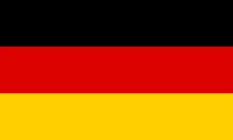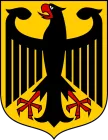Germany

Geographical Location of Germany
Germany consists of three distinct landscape regions: the northern German lowlands with coastal areas to the North and Baltic Seas, the mountainous regions in the center of the country, and the highlands in the south that make up the northernmost parts of the Alps. The variety of landscapes means that the country has a varied climate. The north has a temperate coastal climate with hot summers and mild winters. To the south there is a typical central European inland climate with large variations between seasons.
Many rivers flow through Germany, the largest of which are the Danube, Rhine and Elbe. Rivers played an important role in the country's central role in European trade. Much of the country is heavily polluted by emissions from heavy industry, which has led to acid rain and poor soil. Areas of the former East Germany are particularly plagued by pollution after years of poor environmental regulation. By pursuing aggressive climate policies, Germany has managed to reduce greenhouse gas emissions since the 1990s.
Brief History of Germany
Centuries BC, what is now Germany was inhabited by Germans and Celts, but between 50 BC and 400 AD, the Romans also conquered territory. Several groups of people fought over these lands in the following centuries before Otto I became Holy Roman Emperor in 962. This was the beginning of the Holy Roman Empire, a collection of smaller entities that were more or less self-governing. For a long time, national unity was only a formality, and the power of the emperor was limited. The kingdom lasted until the Napoleonic Wars in the early 19th century.
After repeated attempts to create alliances between the kingdoms in the 19th century, the German Empire was founded in 1871, with William I as Emperor. The Empire included most of what is now Poland, as well as several colonies in Africa. After Germany found itself on the losing side in World War I, the German Empire collapsed. The empire was replaced by the Weimar Republic, which had to give up large territories and pay huge sums of war reparations as part of the military settlement. The harsh conditions contributed to the rise of Nazism under Adolf Hitler in the early 1930s. In 1939, Germany started World War II by invading Poland. After defeat in World War II, Germany and Berlin were divided into four zones and, since 1949, divided into West Germany and East Germany. Germany reunited into one state in 1990.
Society and Politics of Germany
Since 1990, West Germany's 1949 constitution applies to the entire country. The country is a federal republic consisting of 16 states with extensive self-government. The formal head of the country is the president, but in reality most of the power belongs to the chancellor, who heads the government. The legislature joins the bicameral assembly. The country's most important assembly is the Bundestag, where 598 representatives are elected every four years through a combination of majority elections in individual districts and proportional representation.
Politics is dominated by the Christian Democratic CDU and the Social Democratic SPD, which have formed several coalition governments since German reunification. Before the 2021 elections, Angela Merkel resigned after 16 years as chancellor. The SPD narrowly won the election and formed a coalition government with the Greens and the liberal FDP.
The country is a stable democracy and has a well-developed welfare state. Immigration and refugee policies are important domestic political issues in Germany. The country has accepted almost a million refugees since 2015, and opposition to this has given the right-wing populist Alternative for Germany (AfD) party high support. They criticize immigration.
Germany helped found the European Union (EU) and today plays a central role in regional and international cooperation. In recent years, Germany has contributed to international military operations for the first time since World War II. Germany is a member of NATO and has both American military bases and tactical nuclear weapons on its territory. Germany and Russia used to have close ties, but they weakened after Russia's annexation of Crimea and the war in Ukraine.
Economy and Trade of Germany
Germany is the fourth largest economy in the world after the USA, China and Japan. The size is due primarily to a very well-developed export industry, which produces everything from quality electronics and computer equipment to automobiles and industrial equipment. The country is not rich in natural resources, so it must import both energy and most raw materials for industry.
After reunification in 1990, the country entered a period of severe economic recession. This was due to the enormous costs of the transition to a modern market economy in the former East Germany. Having been one of Western Europe's most troubled countries in the 1990s and early 2000s, Germany has had higher economic growth than most other Eurozone countries since 2010. Due to the corona pandemic, the country fell into recession in 2020, but Germany still seems to be doing well compared to many other countries.
Germany also has a low unemployment rate. However, socio-economic development in the states of the former East Germany is lower than in the states that formerly belonged to West Germany. Unemployment is also much higher in the eastern parts of the country. The coming waves of older people and large government spending on pensions could also pose a future challenge for the German economy.
Today, Germany is the fourth largest donor to UN peacekeeping operations and the second largest donor to UN development assistance.
German Cuisine and Culinary Traditions of Germany
German cuisine is an example of very tasty and nutritious food recipes. German cuisine contains a very large number of meat dishes. Various dishes made from pork, beef and poultry are very popular in Germany; in addition, given that Germany has access to the sea, German cuisine also includes many fish dishes. There is no doubt that it was German cuisine that opened up the world of sausages - there are so many different types of sausages in no other country in the world, and these are not just different names for sausages, but their actual different types, radically different from each other. In German cuisine, there are both raw sausages, which are boiled, fried or otherwise subjected to heat treatment before consumption, and a variety of prepared sausages - from boiled to dry-cured. In addition, in one form or another, sausages are included in many traditional German dishes. https://kashevar.com/en/recipes/germany But German cuisine is rich in more than just meat and sausages - it includes many recipes for salads, pastries, sweet desserts and traditional German drinks, among which beer and schnapps play a leading role.







